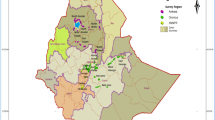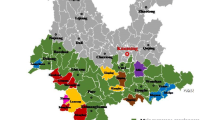Abstract
Sugarcane wilt caused by Fusarium sacchari is an important stalk disease in India which affects sugarcane production both in tropical and sub-tropical regions. Both the sett (stem cutting) and soil borne inocula of the pathogen are responsible for pre and post-germination death of settlings, expression of pokkah boeng (PB) and wilt during different growth stages leading to losses in number of millable (harvestable) canes, cane weight and juice quality. It is presumed that F. sacchari infection and severity are associated with different biotic and abiotic factors in different regions and the root borer, Polyocha depressella is assumed to play a major role in wilt epidemiology. During 2014–2017 we observed severe outbreaks of wilt in the parental collections, and hence undertook a detailed study on wilt and infestation of insect pests with more emphasis on root borer (RB). We analysed the data to establish the possible role played by the insect pests in predisposing the wilt in sugarcane clones. Of the total clones it was found that 321 (57.6%) clones were infested by root borer and 354 (63.6%) clones were prone to wilt at various levels of severities either as mild droo**/yellowing of leaves to severe wilting and drying of canes. Among the 354 clones with wilt infection, ~ 223 had RB infestation and ~ 131 exhibited wilt alone with no RB infestation. Of the 321 clones with RB infestation, 98 remained free from any wilt incidence which indicated that 37% of the wilt affected canes did not show an association of RB and 30.5% of RB infested canes did not show F. sacchari infection revealing a weak relation between the two. Further, the severity of RB infestation remained low at 10% or less and ~ 23 clones exhibited moderate incidence. The present study established that F. sacchari infection in sugarcane occurs independently of RB and other pests attack under field conditions.





Similar content being viewed by others
References
Agnihotri VP (1986) Wilt-scale insect complex in sugarcane; an overview. Bharatiya Sugar 11:71–82
Agnihotri VP, Rao GP (2002) A century status of sugarcane wilt in India. In: Singh SB, Rao GP, Eswaramoorthy S (eds) Sugarcane crop management. SCI TECH Publishing LLC, Houston, pp 145–160
Avasthy PN (1978) Sugarcane scale insect and its control. Co-Op Sugar 10:53–54
Butler EJ, Khan AH (1913) Some new sugarcane diseases. Part T, Wilt, Mem Depart Agri, India. Bot Series 6:180–190
Jayanthi R, David H (1990) Root borer Emmalocera depressella (Swinh.) problem in south India—a current appraisal. Co-Op Sugar 21:807–810
Jayanthi R, Salin KP (1993) Annual Report 1992–93. In: Sugarcane Breeding Institute, Coimbatore, pp 64–65
Jayanthi R, David H, Salin KP (1992) Annual Report 1991–92. In: Sugarcane Breeding Institute, Coimbatore, pp 66
Kulshreshtha JPA, Avasthy PM (1959) An estimate of damage crossed to sugarcane crop by the stalk borer Chilo traeaauricilia Dudg. Proc All India Conf Sugarcane Res Dev Workers 3:27–28
Pandya HV, Patel CB, Patel MB, Patel JR, Radadia GG, Bhatt TA, Vyas ST, Mehta VR, Patel KK, Patel JM (1996a) Association of root borer with wilt disease in sugarcane. Co-Op Sugar 27(9):680
Pandya HV, Patel CB, Patel MB, Patel JR, Radadia GG, Bhatt TA, Vyas ST (1996b) Biology of sugarcane root borer. Co-Op Sugar 27(12):915–918
Poongothai M, Viswanathan R, Malathi P, Ramesh Sundar A (2014a) Sugarcane wilt: pathogen recovery from different tissues and variation in cultural characters. Sugar Tech 16:50–66
Poongothai M, Viswanathan R, Malathi P, Ramesh Sundar A (2014b) Fusarium sacchari causing sugarcane wilt: Variation in morphological characteristics of the pathogen. Intern Sugar J 116:54–63
Sardana HR (1993) Effect of root borer, Emmalocera depressella (Swinhoe) infestation on cane weight and juice quality. Plant Protect Bull (faridabad) 45(4):26–27
Sardana HR (2000) Integrated management of sugarcane root borer, Emmalocera Depressella Swinhoe. Co-Op Sugar 32(4):271–274
Sardana HR, Singh N, Tripathi BK (2000) Investigation on the relationship between root borer and wilt disease of sugarcane. Indian J Entomol 62:11–17
Sarma MN (1971) Some observation on sugarcane disease complex in Nizamabad district of Andhra Pradesh. Indian Sugar 21:619–627
Sarma MN (1976) Wilt disease of sugarcane. Sugarcane Pathol Newsl 15(16):30–33
Srikanth J, Jayanthi R, Salin KP (2014) Sugarcane root borer Polyocha depressella Swinhoe: an overview. J Sugarcane Res 4(2):1–20
Subba Raja KT, Natarajan S (1972) Sugarcane wilt caused by Cephalosporium sacchari and Fusarium moniliforme in India. Sugarcane Pathol Newsl 8:21–23
Sundara B (1998) Sugarcane cultivation. Vikas Publishing House, New Delhi, p p292
Viswanathan R (2010) Plant disease: red rot of sugarcane. Anmol Publishers, New Delhi, p p306
Viswanathan R (2012) Sugarcane diseases and their management, sugarcane breeding institute, Coimbatore, India, p 140
Viswanathan R (2013) Status of sugarcane wilt: one hundred years after its occurrence in India. J Sugarcane Res 3(2):86–106
Viswanathan R (2018) Changing scenario of sugarcane diseases in India since introduction of hybrid cane varieties: path travelled for a century. J Sugarcane Res 8(1):177–211
Viswanathan R (2020) Fusarium diseases affecting sugarcane production in India. Indian Phytopathol 73:415–424. https://doi.org/10.1007/s42360-020-00241-y
Viswanathan R, Malathi P, Sundar AR, Poongothai M, Singh N (2006) Current status of sugarcane wilt in India. Sugar Cane Intern 24(4):1–7
Viswanathan R, Poongothai M, Malathi P (2011) Pathogenic and molecular confirmation of Fusarium sacchari causing wilt in sugarcane. Sugar Tech 13:68–76
Viswanathan R, Poongothai M, Malathi P, Sundar AR (2012) Sugarcane wilt: new insights into the pathogen identity, variability and pathogenicity. In: Viswanathan R, Sundar AR (eds) Functional plant science and biotechnology 6, special issue 2. Global Science Books, Ikenobe, pp 30–39
Viswanathan R, Malathi P, Annadurai A, Prasanth CN, Scindiya M (2014) Sudden occurrence of wilt and pokkah boeng in sugarcane and status of resistance in the parental clones in national hybridization garden to these diseases. J Sugarcane Res 4(1):62–81
Viswanathan R, Poongothai M, Malathi P, Prasanth CN (2015) Sugarcane wilt: simulation of pathogenicity through different methods and environments. Intern Sugar J 117:286–293
Viswanathan R, Balaji CG, Selvakumar R, Malathi P, Ramesh Sundar A, Prasanth CN, Chhabra ML, Parameswari B (2017) Epidemiology of Fusarium diseases in sugarcane: a new discovery of same Fusarium sacchari causing two distinct diseases, wilt and pokkah boeng. Sugar Tech 19:638–646
Viswanathan R, Balaji CG, Selvakumar R, Malathi P, Ramesh Sundar A, Annadurai A, Pazhany AS, Manivannan K, Nithyanantham R (2019) Identification of sources of resistance to wilt caused by Fusarium sacchari in Indian sugarcane parental population. Intern Sugar J 121:838–846
Acknowledgements
The authors are grateful to the Director of the Institute for providing necessary facilities to carry out the work.
Funding
Financial support was received under Outreach Project on PhytoFuRa of ICAR, New Delhi to carry out the research work.
Author information
Authors and Affiliations
Corresponding author
Ethics declarations
Conflict of interest
The authors declare that they have no conflict of interest.
Research involving human participants and/or animals
The present research did not involve human participants and/or animals.
Informed consent
Informed consent was obtained from all individual participants included in the study.
Additional information
Publisher's Note
Springer Nature remains neutral with regard to jurisdictional claims in published maps and institutional affiliations.
Supplementary Information
Below is the link to the electronic supplementary material.
Rights and permissions
About this article
Cite this article
Viswanathan, R., Selvakumar, R., Geetha, N. et al. Epidemiology of sugarcane wilt: predisposition by root borer Polyocha depresella a myth or reality. Indian Phytopathology 75, 3–14 (2022). https://doi.org/10.1007/s42360-021-00398-0
Received:
Revised:
Accepted:
Published:
Issue Date:
DOI: https://doi.org/10.1007/s42360-021-00398-0




